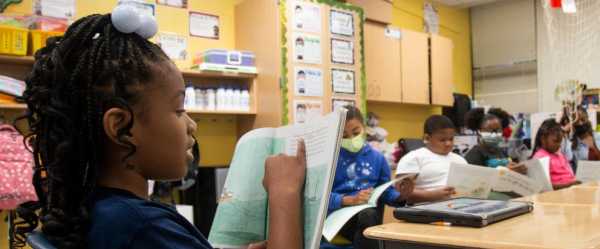
Move over “Dick and Jane.” A different approach to teaching kids how to read is on the rise.
For decades, two schools of thought have clashed on how to best teach children to read, with passionate backers on each side of the so-called reading wars. The battle has reached into homes via commercials for Hooked on Phonics materials and through shoebox dioramas assigned by teachers seeking to instill a love of literature.
But momentum has shifted lately in favor of the “science of reading.” The term refers to decades of research in fields including brain science that point to effective strategies for teaching kids to read.
The science of reading is especially crucial for struggling readers, but school curricula and programs that train teachers have been slow to embrace it. The approach began to catch on before schools went online in spring 2020. But a push to teach all students this way has intensified as schools look for ways to regain ground lost during the pandemic — and as parents of kids who can't read demand swift change.
OK, CLASS. TIME FOR A HISTORY LESSON.
One historical approach to teaching reading was known as “whole language.” (Close cousins of this approach are “whole word” and “look-say.”) It focused on learning entire words, placing the emphasis on meaning. A famous example is the “Dick and Jane” series, which, like many modern-day books for early readers, repeated words frequently so students could memorize them.
The other approach involved phonics, with supporters arguing students need detailed instruction on the building blocks of reading. That meant lots of time on letter sounds and how to combine them into words.
In 2000, a government-formed National Reading Panel released the findings of its exhaustive examination of the research. It declared phonics instruction was crucial to teaching young readers, along with several related concepts.
Whole language had lost.
What emerged, though, was an informal truce that came to be known as “balanced literacy” and borrowed from both approaches. The goal: Get kids into books they found enjoyable as quickly as possible.
But in practice, phonics elements often got short shrift, said Michael Kamil, professor emeritus of education at Stanford University.
“It wasn’t a true compromise,” said Kamil, who had sat on the national reading panel. The approach often led to students learning how to guess words, instead of how to sound them out.
Now, as schools look to address low reading scores, phonics and other elements of the science of reading are getting fresh attention, fueled in part by a series of stories and podcasts by APM Reports. Textbook makers are adding more phonics, and schools have dumped some popular programs that lacked that approach.
WHAT IS THE SCIENCE OF READING?
While the phrase doesn’t have a universal definition, it refers broadly to research in a variety of fields that relates to how a child's brain learns to read. Neuroscientists, for instance, have used MRIs to study the brains of struggling readers.
In practice, this science calls for schools to focus on the building blocks of words. Kindergartners might play rhyming games and clap out the individual syllables in a word to learn to manipulate sounds. Experts call this phonemic awareness.
Students later will learn explicitly how to make letter sounds and blend letters. To make sure students aren’t just guessing at words, teachers might ask them to sound out so-called nonsense words, like “nant” or “zim.”
Gone is rote memorization of word spellings. Instead, students learn the elements that make up a word. In a lesson using the word “unhappy,” students would learn how the prefix “un-” changed the meaning of the base word.
WHY DOES IT MATTER?
For some kids, reading happens almost magically. Bedtime stories and perhaps a little “Sesame Street” are enough.
But 30% to 40% of kids will need the more explicit instruction that is part of the science of reading, said Timothy Shanahan, a professor emeritus at the University of Illinois at Chicago.
Other kids fall somewhere in between. “They’re going to learn to read,” said Shanahan, also one of the members of the 2000 panel and the former director of reading for Chicago Public Schools. “They’re just not going to read as well as they could be or should be.”
Complicating the situation, colleges of education often have stuck with balanced literacy despite concerns about its effectiveness. That means teachers graduate with little background on research-backed instructional methods.
The upshot: Parents often pick up the slack, paying for tutors or workbooks when their children struggle, Shanahan said. Extra help can be costly, contributing to racial and income-based disparities.
As a result, a growing number of NAACP chapters are pushing for wider adoption of the science of reading, describing literacy as a civil rights issue.
WHAT IS DYSLEXIA'S ROLE IN THE READING DEBATE?
Parents of children with dyslexia have led the push to use the science of reading. For them, the issue has special urgency. Kids with dyslexia can learn to read, but they need systematic instruction. When the wrong approach is used, they often flounder.
“I can’t even tell you how many screaming fits we had,” recalled Sheila Salmond, whose youngest child has dyslexia. “My daughter would come home and say, ‘Mom, I’m not learning.’ And then it became, ‘Mom, I’m stupid.’”
Salmond found herself testifying before Missouri lawmakers, taking a graduate class so she could tutor her daughter and eventually moving her from a suburban Kansas City district to a parochial school. She now is making progress.
WHAT IS CHANGING?
Just a decade ago, it was rare for a state to have laws that mentioned dyslexia or the science of reading.
Now every state has passed some form of legislation. The laws variously define what dyslexia is, require that students are screened for reading problems and mandate that teachers are trained in the most effective strategies, said Mary Wennersten, of the International Dyslexia Association.
States often look to duplicate what has happened in Mississippi, which has credited reading gains to a curriculum revamp that started a decade ago. The multi-million dollar effort includes training teachers on the science of reading.
The changes have put some curriculum programs in the crosshairs.
Some Colorado districts, for instance, have ditched instructional materials that didn’t pass muster under a state law that requires schools to use scientifically based reading programs. New York City, whose mayor often talks about his personal struggle with dyslexia, is making changes in its schools as well.
WHAT DOES THE SCIENCE OF READING MEAN FOR PARENTS?
Should they be researching the tenets of the science of reading? Do they need to help their children form letters out of Play-Doh? What about drilling their kids on nonsense words? Flashcards?
Only if they want to, said Amelia Malone, director of research and innovation at the National Center for Learning Disabilities.
What parents must do, she said, is read to their kids. Otherwise, she recommends helping teachers when they ask for it and pushing for evidence-based practices in their children’s schools.
“Parents can be part of the solution," she said, "if we educate them on why this is kind of the movement we need.”
___
The Associated Press education team receives support from the Carnegie Corporation of New York. The AP is solely responsible for all content.
Sourse: abcnews.go.com





